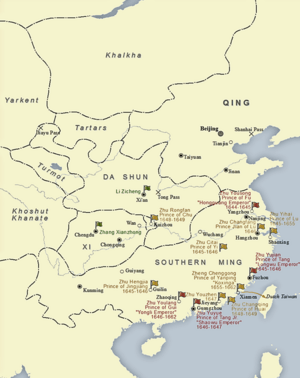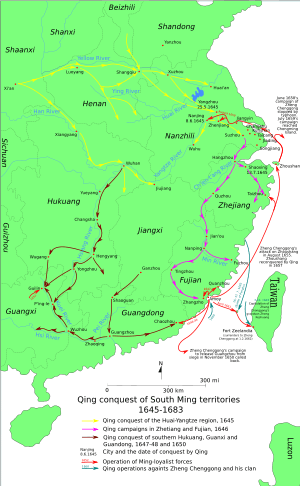Southern Ming facts for kids
The Southern Ming (1644-1683) was a group of governments in southern China. These governments were set up by members of the Ming Dynasty royal family after their capital city, Beijing, was captured. Many people see the Southern Ming as a way the Ming Dynasty continued, even after its main government fell.
In 1644, a rebel army led by Li Zicheng took over Beijing. The last Ming emperor, Emperor Chongzhen, sadly took his own life. After this, the Qing army moved into central China. Most of the Ming royal family and their officials fled to the south. They hoped to use the southern lands, especially south of the Huaihe River, to fight back against the Qing army.
Several different Southern Ming governments were formed. These included the Hongguang, Lu Kingdom, Longwu, Shaowu, Yongli, and Ming Zheng regimes. Each one tried to keep the Ming Dynasty alive.
Contents
The Hongguang Emperor
In 1644, after Emperor Chongzhen died, a prince named Zhu Yousong became emperor in Nanjing. He was known as the Hongguang Emperor.
Fall of Nanjing
The Qing army quickly moved south and attacked the city of Yangzhou. The city was destroyed, and the Qing army carried out a terrible massacre. This event is known as "the 10th day of Yangzhou." Soon after, Nanjing also fell, and the Hongguang Emperor was captured.
The Longwu Emperor
In 1645, another prince, Zhu Yujian, became emperor in Fuzhou. He was supported by a powerful leader named Zheng Zhilong. This new emperor was called the Longwu Emperor.
Fighting the Qing Dynasty
The Longwu Emperor tried to launch an attack to the north against the Qing. His minister, Huang Daozhou, led this effort. The Longwu government also worked with peasant rebel groups to fight the Qing Dynasty.
However, things got worse when Zheng Zhilong surrendered to the Qing. The Longwu Emperor was captured and later died from a hunger strike. The Qing army then quickly took control of most of Southeast China.
The Yongli Emperor
When the situation was very difficult, the remaining Daxi Army and Ming officials joined forces. They supported Zhu Youlang, a prince who became emperor in southwest China. He was known as the Yongli Emperor.
A Strong Fight Back
At the same time, a famous general named Zheng Chenggong (who was Zheng Zhilong's son) became very powerful along the Southeast coast. He attacked the Qing army from the east, while the Yongli forces attacked from the west. This made the fight against the Qing very strong.
However, disagreements among the Ming leaders and constant attacks from the Qing army soon broke down the Ming defenses.
End of the Yongli Reign
In 1661, a general named Wu Sangui led the Qing army into Myanmar. The king of Myanmar handed over the Yongli Emperor to the Qing army. The next year, Wu Sangui had the Yongli Emperor and his son killed in Kunming.
The Ming Zheng Regime
After the Yongli Emperor's death, Zheng Chenggong continued to honor the Ming Dynasty. He took control of Taiwan and made it a base to resist the Qing Dynasty. This government was known as the Ming Zheng regime.
Taiwan as a Base
The Ming Zheng regime continued to use the Yongli Emperor's calendar year. However, they did not support a new Ming emperor or a supervisor. Taiwan became their stronghold against the Qing.
Final Fall
In 1683, the Qing army finally captured Taiwan. Zheng Keshuang, who was the leader of the Ming Zheng regime at the time, surrendered to the Qing Dynasty. Another Ming prince, Zhu Shugui, took his own life. With this, the last forces of the Southern Ming Dynasty were completely defeated.
Images for kids
-
A cannon made in 1650 by the Southern Ming, when they were based in Guangdong. (From the Hong Kong Museum of Coastal Defence.)
-
A letter from Empress Dowager Helena Wang (the "honorary mother" of the Yongli emperor) to the Pope, asking for help. This was written in November 1650.
See also
 In Spanish: Dinastía de los Ming del Sur para niños
In Spanish: Dinastía de los Ming del Sur para niños






